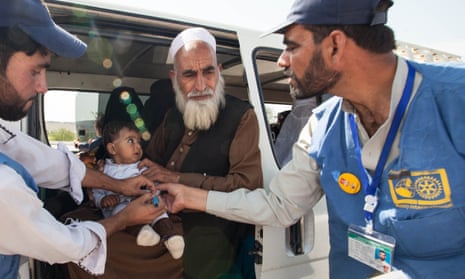The unmonitored movement of people across the border between Pakistan and Afghanistan threatens efforts to eradicate polio from the two countries, as the year’s first cases of the virus are recorded in the volatile region.
The Global Polio Eradication Initiative said people travelling through unchecked crossings is believed to be one of the main causes of the spread of the disease in the area.
Pakistan and Afghanistan, along with Nigeria, are the only three countries in the world where polio remains endemic.
Last month, the year’s first case of the wild poliovirus in Pakistan was reported by the Bajaur Agency in the country’s federally administered tribal area, bordering Afghanistan. The virus was also found in the border towns of Balochistan and Khyber Pakhtunkhwa provinces.
While the border areas are the main source of concern, cases were also reported in January in Punjab province.
Since the start of the polio eradication programme in Pakistan in 1994, virus cases have been consistently reported along the 2,430km-stretch of the border, from main towns and cities to remote villages.

The worst outbreak of polio in Pakistan was recorded in 2014, when 202 cases were reported. The government blamed the Taliban for banning immunisations and launching attacks on vaccination teams.
Efforts by the Global Polio Eradication Initiative – which is supported by the World Health Organization, Unicef, Rotary International and NGOs, along with national governments of polio-affected countries – have yielded results. Since 2015, the number of cases have been steadily declining.
According to Pakistan government figures, there were 54 reports of poliovirus in 2015, followed by 20 in 2016 and eight in 2017. But there was an increase in numbers last year, when a dozen cases were reported throughout the country, with 11 of them coming from the border regions.
Aziz Memon, the national chair of the Pakistan Polio Plus Committee, said the government had increased the number of manned permanent transit posts, across the Pakistan/Afghanistan border, where children can be vaccinated against the virus.
By the end of December, 1.6 million children had been vaccinated at more than 380 such points.
According to Memon, conflict, political insecurity and remoteness of areas, combined with a highly mobile population and logistical challenges, are significant obstacles to Pakistan eradicating polio.
“Cross-border vaccination is critical to our programme in the fight against polio. The mass influx of population has caused many to fall through the cracks and families with children with low routine and no supplementary immunisation are the real challenge to the programme,” he said.
The difficult geographical terrain between North and South Waziristan and south-eastern Afghanistan has been the most difficult to reach for immunisation teams.
The committee’s current target is to immunise high risk populations in the border towns of Peshawar/Torkham in Khyber Pakhtunkhwa and Chaman/Spin Boldik in Balochistan. These areas are home to nomads, seasonal and economic migrants, and agricultural migrant labourer families.
The storage capacity of vaccines in high temperatures in these areas has been a challenge. But researchers from the Southern University of California say they have found a new method of storing inactive poliovirus vaccine (IPV) that maintains its effectiveness in such weather conditions.
There has been a 96% reduction in the number of polio cases in Pakistan since 2014. According to government figures 38.7 million children under five have been immunised in routine national immunisation days.
Polio is a highly infectious, disabling and potentially deadly disease, contracted through the poliomyelitis virus in areas with poor sanitation. It spreads through contaminated food and water. There is no cure, and the disease mainly affects young children, so early immunisation is the only defence.
Consequently, reaching children at the right age is a principal focus of the immunisation teams. The vaccine is given to children in four doses between the ages of two months and six years.
In 2017 Pakistan started building a fence along its border with Afghanistan. While the aim is largely political, to limit militant incursions from either sides, the government also claims this will help stop cross-border transmission of polio.








